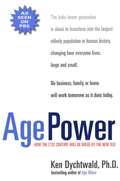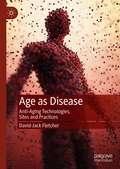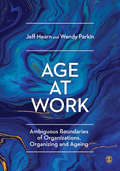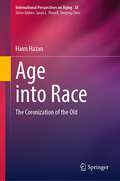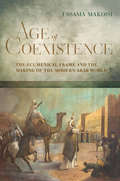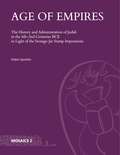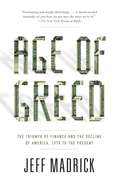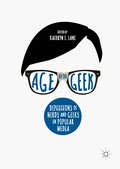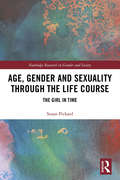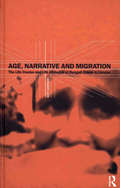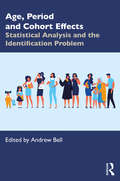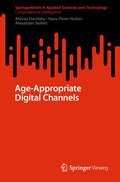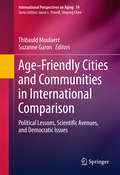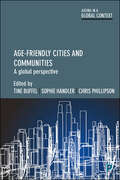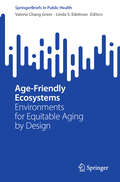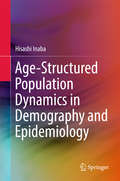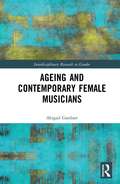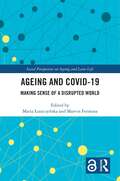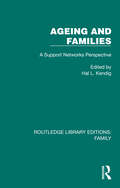- Table View
- List View
Age Power: How the 21st Century Will Be Ruled By the New Old
by Ken DychtwaldIn this breakthrough book, Dychtwald explains how individuals, businesses, and governments can best prepare for a new era in which the priorities of our homes and nation will be set by the needs and desires of the elderly. He surveys how each of us must make individual decisions right now to "age-proof" our lives.
Age as Disease: Anti-Aging Technologies, Sites and Practices
by David-Jack FletcherAge as Disease explores the foundations of gerontology as a discipline to examine the ways contemporary society constructs old age as a disease-state. Framed throughout as ‘gerontological hygeine’, this book examines contemporary regimes, strategies and treatment protocols deployed throughout Australia, the United States, and the United Kingdom. The book deploys critical cultural theories such as biopolitics, somatechnics, ethics, and governmentality to examine how anti-aging technologies operate to problematise the aging body as always-already diseased, and how these come to constitute a movement of abolition, named here as ‘gerontological hygiene’.
Age at Work: Ambiguous Boundaries of Organizations, Organizing and Ageing
by Jeff Hearn Wendy ParkinAge at Work explores the myriad ways in which ‘age’ is at ‘work’ across society, organizations and workplaces, with special focus on organizations, their boundaries, and marginalizing processes around age and ageism in and across these spaces. The book examines: how society operates in and through age, and how this informs the very existence of organizations; age-organization regimes, age-organization boundaries, and the relationship between organizations and death, and post-death the importance of memory, forgetting and rememorizing in re-thinking the authors’ and others’ earlier work tensions between seeing age in terms of later life and seeing age as pervasive social relations. Enriched with insights from the authors’ lived experiences, Age at Work is a major and timely intervention in studies of age, work, care and organizations. Ideal for students of Sociology, Organizations and Management, Social Policy, Gerontology, Health and Social Care, and Social Work.
Age at Work: Ambiguous Boundaries of Organizations, Organizing and Ageing
by Jeff Hearn Wendy ParkinAge at Work explores the myriad ways in which ‘age’ is at ‘work’ across society, organizations and workplaces, with special focus on organizations, their boundaries, and marginalizing processes around age and ageism in and across these spaces. The book examines: how society operates in and through age, and how this informs the very existence of organizations; age-organization regimes, age-organization boundaries, and the relationship between organizations and death, and post-death the importance of memory, forgetting and rememorizing in re-thinking the authors’ and others’ earlier work tensions between seeing age in terms of later life and seeing age as pervasive social relations. Enriched with insights from the authors’ lived experiences, Age at Work is a major and timely intervention in studies of age, work, care and organizations. Ideal for students of Sociology, Organizations and Management, Social Policy, Gerontology, Health and Social Care, and Social Work.
Age into Race: The Coronization of the Old (International Perspectives on Aging #38)
by Haim HazanAge into Race is a socio-anthropological essay on the repercussions of the Covid-19 pandemic on the cultural status of the old. As the worldwide horrors of the Corona era have since been publicly repressed, the text is geared to revisit and relive the tenor of that time while considering its latent revolutionary aftermath. There was wide agreement that Covid-19 policies targeted older people as a risk group in need of protection, setting it apart from the rest of society. Yet, paradoxically, long-term facilities for older people effectively became Covid-19 death traps. What kind of abandonment propelled this apparent contradiction? This book provides an answer by looking at ageist practices regarding Covid-19 triaging, lockdowns and distancing that affected older people around the world, devising Covid-19 as an inevitable "problem of the elderly" and, by implication, instating and categorizing "the elderly" as a public problem to be bio-politically managed and wrought. The Covid-19 pandemic and its concomitant "state of emergency" triggered an accelerated transmutation of customary ageism into emergent racism, spelling a fatal switch to designating the old as bearers of "bare" life unworthy of human living, thus turning old age from a seemingly cultural category to a socially fabricated viral menace of nature. The book tracks down the process through which the "Coronization" of culture legitimized and impelled a further stigmatization of old age beyond mere ageism to sheer racism. Thus, this transmutation, while compromising their autonomy and subjectivity via imposed lockdowns, social isolation, excommunication and selective discrimination rendered the old a race apart. Subsequently, the moral panic invoked by the specter of the pandemic transformed the social perceptions of later life from a containable social problem to an unbridled public hazard that summoned total measures presented as bureaucratically regimented regulations that dehumanized its victims with impunity.
Age of Coexistence: The Ecumenical Frame and the Making of the Modern Arab World
by Ussama MakdisiToday’s headlines paint the Middle East as a collection of war-torn countries and extremist groups consumed by sectarian rage. Ussama Makdisi’s Age of Coexistence reveals a hidden and hopeful story that counters this clichéd portrayal. It shows how a region rich with ethnic and religious diversity created a modern culture of coexistence amid Ottoman reformation, European colonialism, and the emergence of nationalism. Moving from the nineteenth century to the present, this groundbreaking book explores, without denial or equivocation, the politics of pluralism during the Ottoman Empire and in the post-Ottoman Arab world. Rather than judging the Arab world as a place of age-old sectarian animosities, Age of Coexistence describes the forging of a complex system of coexistence, what Makdisi calls the “ecumenical frame.” He argues that new forms of antisectarian politics, and some of the most important examples of Muslim-Christian political collaboration, crystallized to make and define the modern Arab world. Despite massive challenges and setbacks, and despite the persistence of colonialism and authoritarianism, this framework for coexistence has endured for nearly a century. It is a reminder that religious diversity does not automatically lead to sectarianism. Instead, as Makdisi demonstrates, people of different faiths, but not necessarily of different political outlooks, have consistently tried to build modern societies that transcend religious and sectarian differences.
Age of Confidence: Celebrating Twenty Years of Jewish Renaissance
by Howard Jacobson Rebecca Taylor David BenmayerTaking the terrorist attacks of 9/11 as their starting point, five new essays look at how Jewish culture has changed over the past two decades. Covering music (Vanessa Paloma Elbaz), art (Monica Bohm Duchen), literature (Bryan Cheyette), theatre (Judi Herman) and film (Nathan Abrams), the essays explore the role of confidence in the cultural output of minority communities, and ask whether the trends identified look set to continue over the coming years.Commissioned to mark the twentieth anniversary of Jewish Renaissance magazine, the book includes a foreword by Howard Jacobson and is interspersed with a selection of the best articles from the magazine’s archive, including pieces by the director Mike Leigh, author Linda Grant and sociologist Keith Kahn-Harris.
Age of Empires: The History and Administration of Judah in the 8th–2nd Centuries BCE in Light of the Storage-Jar Stamp Impressions (Mosaics: Studies on Ancient Israel #2)
by Oded LipschitsStorage jars of many shapes and sizes were in widespread use in the ancient world, transporting and storing agricultural products such as wine and oil, crucial to agriculture, economy, trade and subsistence. From the late 8th to the 2nd century BCE, the oval storage jars typical of Judah were often stamped or otherwise marked: in the late 8th and early 7th century BCE with lmlk stamp impressions, later in the 7th century with concentric circle incisions or rosette stamp impressions, in the 6th century, after the fall of Jerusalem, with lion stamp impressions, and in the Persian, Ptolemaic and Seleucid periods (late 6th–late 2nd centuries BCE) with yhwd stamp impressions. At the same time, several ad hoc systems of stamp impressions appeared: "private" stamp impressions were used on the eve of Sennacherib’s campaign, mwṣh stamp impressions after the destruction of Jerusalem, and yršlm impressions after the establishment of the Hasmonean state. While administrative systems that stamped storage jars are known elsewhere in the ancient Near East, the phenomenon in Judah is unparalleled in its scale, variety and continuity, spanning a period of some 600 years without interruption.This is the first attempt to consider the phenomenon as a whole and to develop a unified theory that would explain the function of these stamp impressions and shed new light on the history of Judah during six centuries of subjugation to the empires that ruled the region—as a vassal kingdom in the age of the Assyrian, Egyptian, and Babylonian empires and as a province under successive Babylonian, Persian, Ptolemaic, and Seleucid rule.
Age of Greed: The Triumph of Finance and the Decline of America, 1970 to the Present
by Jeff MadrickA vividly told history of how greed bred America's economic ills over the last forty years, and of the men most responsible for them.As Jeff Madrick makes clear in a narrative at once sweeping, fast-paced, and incisive, the single-minded pursuit of huge personal wealth has been on the rise in the United States since the 1970s, led by a few individuals who have argued that self-interest guides society more effectively than community concerns. These stewards of American capitalism have insisted on the central and essential place of accumulated wealth through the booms, busts, and recessions of the last half century, giving rise to our current woes.In telling the stories of these politicians, economists, and financiers who declared a moral battle for freedom but instead gave rise to an age of greed, Madrick traces the lineage of some of our nation's most pressing economic problems. He begins with Walter Wriston, head of what would become Citicorp, who led the battle against government regulation. He examines the ideas of economist Milton Friedman, who created the plan for an anti-Rooseveltian America; the politically expedient decisions of Richard Nixon that fueled inflation; the philosophy of Alan Greenspan, on whose libertarian ideology a house of cards was built on Wall Street; and the actions of Sandy Weill, who constructed the largest financial institution in the world, which would have gone bankrupt in 2008 without a federal bailout of $45 billion. Significant figures including Ivan Boesky, Michael Milken, Jack Welch, and Ronald Reagan play key roles as well.Intense economic inequity and instability is the story of our age, and Jeff Madrick tells it with style, clarity, and an unerring command of his subject.From the Hardcover edition.
Age of Icons
by Martijn Konings Gavin FridellCelebrities are increasingly front and centre in public debates on everything from solving world poverty to halting genocide, confronting obesity, and finding spiritual contentment. Bono, Bill Gates, Al Gore, Bob Geldof, Oprah, Madonna, and Angelina Jolie are just some of the entertainers, politicians, pundits, elite business people, and policy-makers whose highly visible political activism has become an integral part of their public personas.These pop icons tend to be celebrated as "philanthrocapitalists" with a unique ability to remedy the world's problems. However, as Age of Icons demonstrates, the solutions these icons promote for addressing global injustice, when examined critically, can be seen to work through the very same institutions that create these problems in the first place.This volume assesses the growing role of popular icons in the construction of a culture that appears to incorporate a critical attitude towards the capitalist experience while, in fact, legitimizing the neoliberal character of the modern world. It will be an eye-opening read for anyone interested in the juncture between current events and celebrity culture.
Age of the Geek: Depictions of Nerds and Geeks in Popular Media
by Kathryn E. LaneThis collection examines the nerd and/or geek stereotype in popular culture today. Utilizing the media--film, TV, YouTube, Twitter, fiction--that often defines daily lives, the contributors interrogate what it means to be labeled a "nerd" or "geek. " While the nerd/geek that is so easily recognized now is assuredly a twenty-first century construct, an examination of the terms' history brings a greater understanding of their evolution. From sports to slasher films, Age of the Geek establishes a dialogue with texts as varied as the depictions of "nerd" or "geek" stereotypes.
Age, Gender and Sexuality through the Life Course: The Girl in Time (Routledge Research in Gender and Society)
by Susan PickardAge, Gender and Sexuality through the Life Course argues that the gendered structure of temporality (defined in the dual sense of everyday time as well as age and stage of life) is a key factor underpinning the stalling of the gender revolution. Taking as its central focus the idealised young woman who serves as the mascot of contemporary success, this book demonstrates how the celebration of the Girl is (i) representative of social mobility, educational and professional achievement; (ii) possesses diligence, docility and emotional intelligence, and (iii) displays a reassuring sexuality and youthfulness – but is constructed from the outset to have a fleetingly short life span. Pickard undertakes a theoretical and empirical exploration of the contemporary female experience of education, work, motherhood, sexuality, the challenge of having-it-all. Furthermore, through additional analysis of the transitional ‘reproductive regime’ from youth into mid-life and beyond, this insightful monograph aims to demonstrate how age and time set very clear limits to what is possible and desirable for the female self; yet how the latter factors also, if used reflexively, can provide the key means of resisting and challenging patriarchy. This book is aimed at a broad interdisciplinary audience located in gender studies, age studies, culture studies, sociology and psychology; accessible for advanced undergraduates and beyond.
Age, Narrative and Migration: The Life Course and Life Histories of Bengali Elders in London
by Katy GardnerWhilst the vast majority of recent research on identity and ethnicity amongst South Asians in Britain has focused upon younger people, this book deals with Bengali elders, the first generation of migrants from Sylhet, in Bangladesh. The book describes how many of these elders face the processes of ageing, sickness and finally death, in a country where they did not expect to stay and where they do not necessarily feel they belong. The ways in which they talk about and deal with this, and in particular, their ambivalence towards Britain and Bangladesh lies at the heart of the book. Centrally, the book is based around the men and womens life stories. In her analysis of these, Gardner shows how narratives play an important role in the formation of both collective and individual identity and are key domains for the articulation of gender and age. Underlying the stories that people tell, and sometimes hidden within their gaps and silences, are often other issues and concerns. Using particular idioms and narrative devices, the elders talk about the contradictions and disjunctions of transmigration, their relationship with and sometimes resistance to, the British State, and what they often present as the breakdown of traditional ways. In addition to this, the book shows that histories, stories and identity are not just narrated through words, but also through the body - an area rarely theorized in studies of migration.
Age, Period and Cohort Effects: Statistical Analysis and the Identification Problem
by Andrew BellAge, Period and Cohort Effects: Statistical Analysis and the Identification Problem gives a number of perspectives from top methodologists and applied researchers on the best ways to attempt to answer Age–Period–Cohort related questions about society. Age–Period–Cohort (APC) analysis is a fundamental topic for any quantitative social scientist studying individuals over time. At the same time, it is also one of the most misunderstood and underestimated topics in quantitative methods. As such, this book is key reference material for researchers wanting to know how to deal with APC issues appropriately in their statistical modelling. It deals with the identification problem caused by the co-linearity of the three variables, considers why some currently used methods are problematic and suggests ideas for what applied researchers interested in APC analysis should do. Whilst the perspectives are varied, the book provides a unified view of the subject in a reader-friendly way that will be accessible to social scientists with a moderate level of quantitative understanding, across the social and health sciences.
Age-Appropriate Digital Channels (SpringerBriefs in Applied Sciences and Technology)
by Alexander Seifert Alireza Darvishy Hans-Peter HutterAs a client or a developer, what do you need to consider when developing an age-appropriate website or mobile application? This book explains how age-related limitations affect the use of websites and mobile applications. If gerontological aspects are not taken into account in the design of digital channels, older people tend to do without them. Therefore, websites and mobile applications need to take into account the needs of older people. In the book, you will find useful recommendations on how to do this so that your websites and mobile apps are easy to use for everyone.
Age-Friendly Cities and Communities in International Comparison: Political Lessons, Scientific Avenues, and Democratic Issues (International Perspectives on Aging)
by Thibauld Moulaert Suzanne GaronThe supportiverole of urban spaces in active aging is explored on a world scale in thisunique resource, using the WHO's Age-Friendly Cities and Community model. Casestudies from the U. S. , Canada, Australia, Hong Kong, and elsewhere demonstratehow the model translates to fit diverse social, political, and economic realitiesacross cultures and continents, ways age-friendly programs promote seniorempowerment, and how their value can be effectively assessed. Age-friendlycriteria for communities are defined and critiqued while extensive empiricaldata describe challenges as they affect elders globally and how environmentalsupport can help meet them. These chapters offer age-friendly cities as acorrective to the overemphasis on the medical aspects of elders' lives, and shouldinspire new research, practice, and public policy. Included in thecoverage: A critical review of the WHO Age-Friendly Cities Methodology and its implementation. Seniors' perspectives on age-friendly communities. The implementation of age-friendly cities in three districts of Argentina. Age-friendly New York City: a case study. Toward an age-friendly European Union. Age-friendliness, childhood, and dementia: toward generationally intelligent environments. With its balanceof attention to universal and culture-specific concerns, Age-Friendly Cities and Communities in International Comparisonwill be of particular interest to sociologists, gerontologists, and policymakers. "Given the rapid adoption ofthe age-friendly perspective, following its development by the World HealthOrganization, the critical assessment offered in this volume is especiallywelcome". Professor ChrisPhillipson, University of Manchester
Age-Friendly Cities and Communities: A Global Perspective (Ageing in a Global Context)
by Tine Buffel, Sophie Handler and Chris PhillipsonAs the drive towards creating age-friendly cities grows, this important book provides a comprehensive survey of theories and policies aimed at improving the quality of life of older people living in urban areas. In this book, part of the Ageing in a Global Context series, leading international researchers critically assess the problems and the potential of designing age-friendly environments. The book considers the different ways in which cities are responding to population ageing, the different strategies for developing age-friendly communities, and the extent to which older people themselves can be involved in the co-production of age-friendly policies and practices. The book includes a manifesto for the age-friendly movement, focused around tackling social inequality and promoting community empowerment.
Age-Friendly Ecosystems: Environments for Equitable Aging by Design (SpringerBriefs in Public Health)
by Valerie Chang Greer Linda S. EdelmanThis compact book examines age friendliness within the framework of age-friendly ecosystems, and from a place-based approach, considering anchor institutions of neighborhoods, campuses and health environments as sites uniquely positioned to catalyze age equity and inclusivity. Age friendliness has grown from an idea into a social movement that recognizes the diversity of older adults, and integrates research, policy, programming and design practices. Compounding pressures of rapid aging, systemic ageism, and a growing disparity of resources compel us to rethink how we achieve equity in aging through the design of places and practices. Content for this book draws from a 2022 symposium, Age Friendly Communities as Platforms for Equity, Health & Wellness. Contributors build upon the content shared through the symposium in order to examine how neighborhoods, campuses and health environments are uniquely poised to support equity and to extend reach to historically marginalized populations of older adults. Ideas and experiences from national experts in aging, as well as "real world" experiences and narratives shared by older adults, students, community stakeholders and faculty researchers, are presented through a place-based approach. Collectively the voices in this book create a lens for empowering age-friendly ecosystems as environments for equitable aging by design. Among the topics covered: Creating an Age-Friendly Environment Across the Ecosystem Age Friendliness as a Framework for Equity in Aging Age-Friendly Voices in the Pursuit of an Age-Friendly Ecosystem Age-Friendly Futures: Equity by Design Age-Friendly Ecosystems: Environments for Equitable Aging by Design is written for people who are interested in understanding how the age-friendly movement is transforming places we live – community planners, designers, policy makers, aging service providers, academics and citizen activists. This compact volume presents a case of need for age friendliness in places we live, learn and care for our health. Readers with interests in the professional practice areas of aging studies/gerontology, architecture and planning, colleges and universities, community/neighborhood development, health systems, research, and policy will benefit from this brief that examines neighborhoods, campuses, and health environments from interdisciplinary perspectives.
Age-Structured Population Dynamics in Demography and Epidemiology
by Hisashi InabaThis book is the first one in which basic demographic models are rigorously formulated by using modern age-structured population dynamics, extended to study real-world population problems. Age structure is a crucial factor in understanding population phenomena, and the essential ideas in demography and epidemiology cannot be understood without mathematical formulation; therefore, this book gives readers a robust mathematical introduction to human population studies. In the first part of the volume, classical demographic models such as the stable population model and its linear extensions, density-dependent nonlinear models, and pair-formation models are formulated by the McKendrick partial differential equation and are analyzed from a dynamical system point of view. In the second part, mathematical models for infectious diseases spreading at the population level are examined by using nonlinear differential equations and a renewal equation. Since an epidemic can be seen as a nonlinear renewal process of an infected population, this book will provide a natural unification point of view for demography and epidemiology. The well-known epidemic threshold principle is formulated by the basic reproduction number, which is also a most important key index in demography. The author develops a universal theory of the basic reproduction number in heterogeneous environments. By introducing the host age structure, epidemic models are developed into more realistic demographic formulations, which are essentially needed to attack urgent epidemiological control problems in the real world.
Ageing Masculinities in Contemporary European and Anglophone Cinema (Routledge Advances in Film Studies)
by Tony Tracy Michaela Schrage-FrühThis volume offers a unique exploration of how ageing masculinities are constructed and represented in contemporary international cinema. With chapters spanning a range of national cinemas, the primarily European focus of the book is juxtaposed with analysis of the social and cultural constructions of manhood and the "anti-ageing" impulses of male stardom in contemporary Hollywood. These themes are inflected in different ways throughout the volume, from considering how old age is not the monolithic and unified life stage with which it is often framed, to exploring issues of queerness, sexuality, and asexuality, as well as themes such as national cinema and dementia. Offering a diverse and multifaceted portrait of ageing and masculinity in contemporary cinema, this book will be of interest to scholars and students of film and screen studies, gender and masculinity studies, and cultural gerontology.
Ageing Matters: European Policy Lessons from the East (Social Policy In Modern Asia Ser.)
by John DolingThe implications of population ageing have long concerned politicians, policy makers and governmental and non-governmental organizations in the welfare states of Europe. However, an ageing workforce is increasingly a matter of concern for the developed and fast-developing countries of Asia. Japan leads the field in this respect on account of the speed of its postwar economic development. But the little tigers of Hong Kong, Singapore, South Korea and Taiwan are poised to catch up, and Malaysia, though in the second tier of developing Asian economics, faces the prospect of population ageing sufficient to daunt an as yet under-prepared infrastructure for old age support. This book is the first to examine in detail the experiences and prospects of population ageing in those Asian countries with the highest GDP per capita. The authors pose the question to what extent Asia and 'old Europe' can learn from each other in terms of policy planning. The first section of the book sets out the field in terms of the demographic characteristics and policy predicaments of European and Asian countries. The second section presents case-studies of six countries: Japan, Hong Kong, Singapore, South Korea, Taiwan and Malaysia.
Ageing and Contemporary Female Musicians (Interdisciplinary Research in Gender)
by Abigail GardnerAgeing and Contemporary Female Musicians focuses on ageing within contemporary popular music. It argues that context, genres, memoirs, racial politics and place all contribute to how women are 'aged' in popular music. Framing contemporary female musicians as canonical grandmothers, Rude Girls, neo-Afrofuturist and memoirists settling accounts, the book gives us some respite from a decline or denial narrative and introduces a dynamism into ageing. Female rock memoirs are age-appropriate survival stories that reframe the histories of punk and independent rock music. Old age has a functional and canonical ‘place’ in the work of Shirley Collins and Calypso Rose. Janelle Monáe, Christine and the Queens and Anohni perform ‘queer’ age, specifically a kind of ‘going beyond’ both corporeal and temporal borders. Genres age, and the book introduces the idea of the time-crunch; an encounter between an embodied, represented age and a genre-age, which is, itself, produced through historicity and aesthetics. Lastly the book goes behind the scenes to draw on interviews and questionnaires with 19 women involved in the contemporary British and American popular music industry; DIY and ex-musicians, producers, music publishers, music journalists and audio engineers. Ageing and Contemporary Female Musicians is a vital intergenerational feminist viewpoint for researchers and students in gender studies, popular music, popular culture, media studies, cultural studies and ageing studies.
Ageing and Covid-19: Making Sense of a Disrupted World (Social Perspectives on Ageing and Later Life)
by Maria ŁuszczyńskaThis volume presents a range of research approaches to the exploration of ageing during a pandemic situation. One of the first collections of its kind, it offers an array of studies employing research methodologies that lend themselves to replication in similar contexts by those seeking to understand the effects of epidemics on older people. Thematically organised, it shows how to reconcile qualitative and quantitative approaches, thus rendering them complementary, bringing together studies from around the world to offer an international perspective on ageing as it relates to an unprecedented epidemiological phenomenon. As such, it will appeal to researchers in the field of gerontology, as well as sociologists of medicine and clinicians seeking to understand the disruptive effects of the recent coronavirus outbreak on later life.
Ageing and Digital Technology: Designing and Evaluating Emerging Technologies for Older Adults
by Barbara Barbosa Neves Frank VetereThis book brings together Sociologists, Computer Scientists, Applied Scientists and Engineers to explore the design, implementation and evaluation of emerging technologies for older people. It offers an innovative and comprehensive overview, not only of the rapidly developing suite of current digital technologies and platforms, but also of perennial theoretical, methodological and ethical issues. As such, it offers support for researchers and professionals who are seeking to understand and/or promote technology use among older adults. The contributions presented here offer theoretical and methodological frameworks for understanding age-based digital inequalities, participation, digital design and socio-gerontechnology. They include ethical and practical reflections on the design and evaluation of emerging technologies for older people, as well as guidelines for ethical, participatory, professional and cross-disciplinary research and practice. In addition, they feature state-of-the-art, international empirical research on communication technologies, games, assistive technology and social media. As the first truly multidisciplinary book on technology use among ageing demographics, and intended for students, researchers, applied researchers, practitioners and professionals in a variety of fields, it will provide these readers with insights, guidelines and paradigms for practice that transcend specific technologies, and lay the groundwork for future research and new directions in innovation.
Ageing and Families: A Support Networks Perspective (Routledge Library Editions: Family)
by Hal L. KendigOriginally published in 1986, this title was a landmark study of ageing in Australia and a major contribution to the study of gerontology at the time. It highlights major themes on ageing in ‘western’ industrialised societies, as well as pinpointing new, emerging themes. For instance, the initial speculations in the 1960s that informal groups such as the family, neighbours, and friends play crucial helping roles for older people. The book also presents data and summarises past studies that show the common characteristics of those delivering and receiving services, such as the special role of women; and within that gender related services, the special importance of children and spouses, the importance of close proximity when people are chronically disabled, the fact that most retired people manage their own lives without help and in fact provide services to their children, and much more, is dealt with. It also looks at how such informal support works alongside the formal agencies, such as nursing homes. The systematic study of how informal and formal systems link together was one of the gaps in gerontological research at the time.
